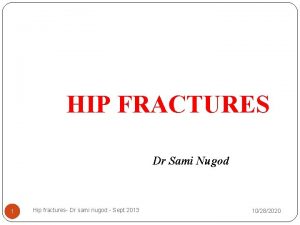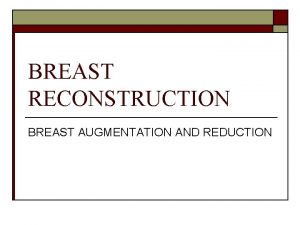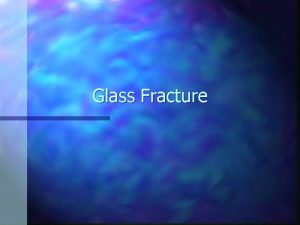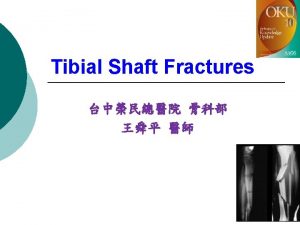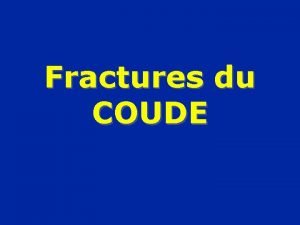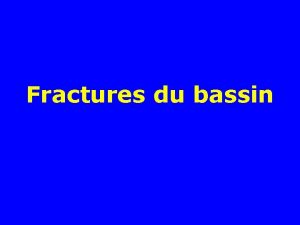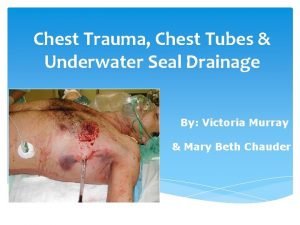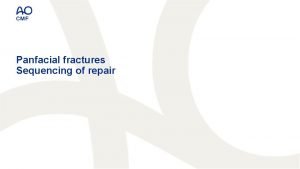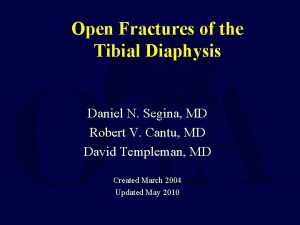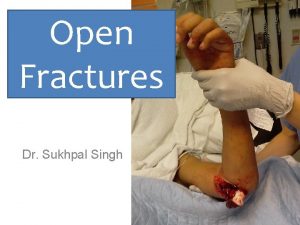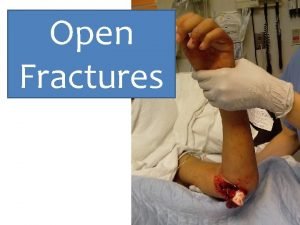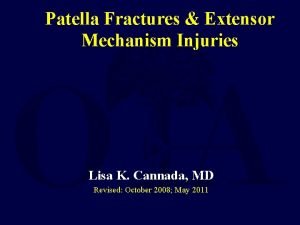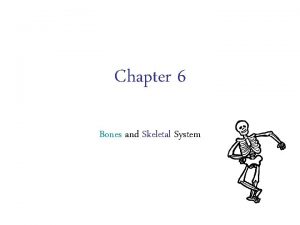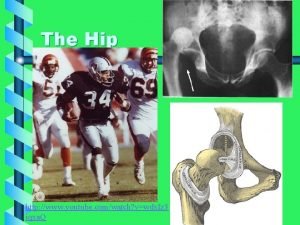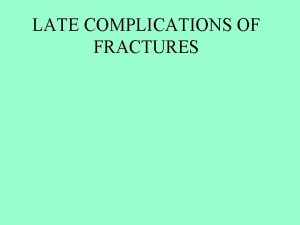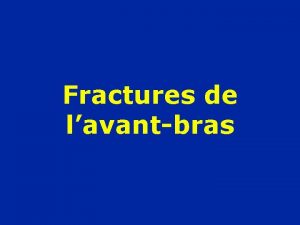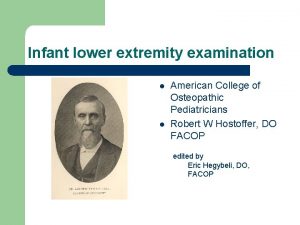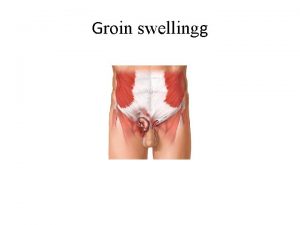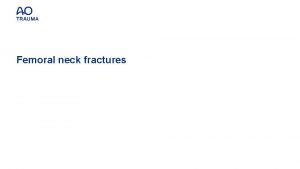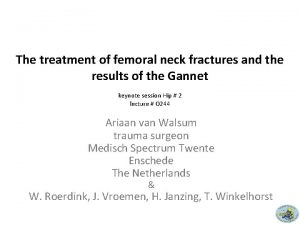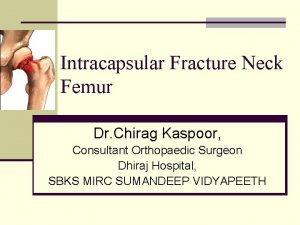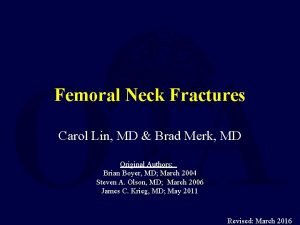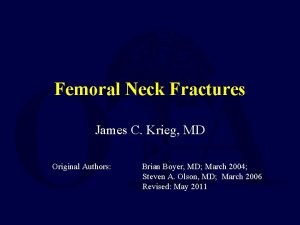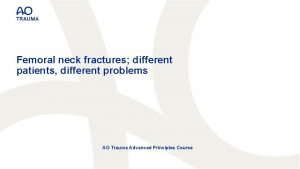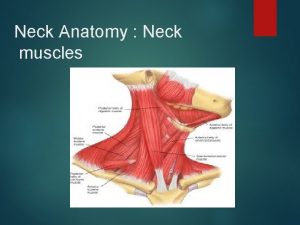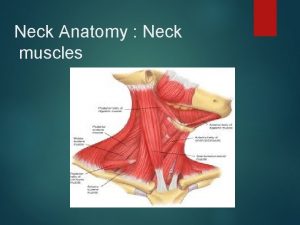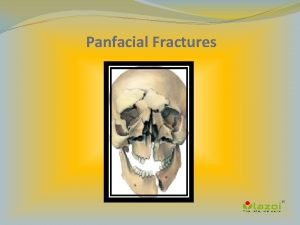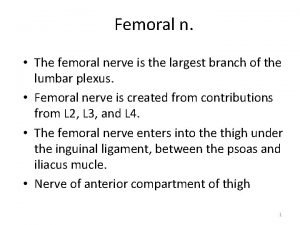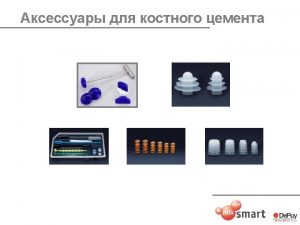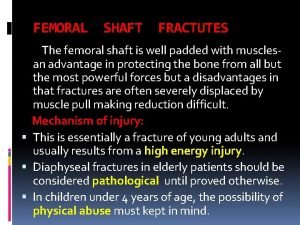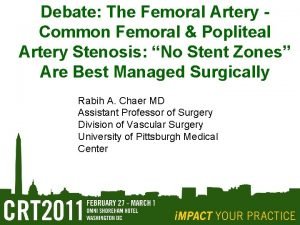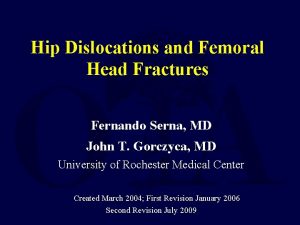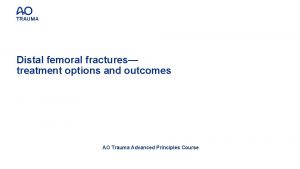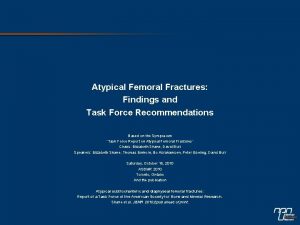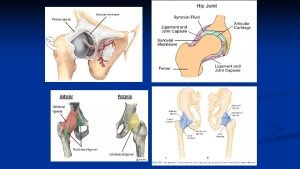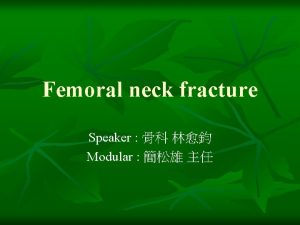Intracapsular fractures of the femoral neck Per and


































- Slides: 34

Intracapsular fractures of the femoral neck Per- and intertrochanteric hip fractures Alan Norrish, Zaid Abual-Rub

Learning outcomes At the end of this lecture you will be able to: • Discuss the importance of blood supply for hip fractures • Explain the importance of positioning, reduction, and perioperative sterility • Describe the implant choice and the procedure step-by-step • Suggest how complications can be avoided

Aim of treatment - Younger patients (age < 65) • • Anatomic reduction and stable internal fixation Preserve femoral head, avoid osteonecrosis, and achieve union Ideally avoid arthroplasty Maximize potential for return to prefracture mobility

Aim of treatment - Elderly patients (age > 65) • Allow immediate weight bearing • Restore prefracture mobility status • Avoid prolonged bed rest complications

Hip fractures • High energy (rare) • Young patients, polytrauma • Low energy (very common) • • 15% of women and 5% of men Osteoporosis most common cause Costs billions every year Mortality: • • 10% at 1 month 30% at 1 year

Blood supply • Blood supply to the femoral head • Comes up from the circumflex artery Lateral epiphyseal arterial group Subsynovial intracapsular arterial ring Ascending cervical arteries Medial femoral circumflex artery Extracapsular arterial ring

Blood supply • Transcervical fractures: • Blood supply is at risk • Necrosis of the femoral head

Classification (AO/OTA Fracture and Dislocation) 31 - A Intertrochanteric hip fractures B C Neck and head fractures

Classification (AO/OTA Fracture and Dislocation) 31 - B • This lecture is about the 31 -B fractures • Different 31 -B subtypes: • Age and physiological status dictate treatment

Classification (AO/OTA Fracture and Dislocation) 31 -B 1 • Subcapital with slight or no displacement • Stable type • • Non-operative Operative: Internal fixation

Classification (AO/OTA Fracture and Dislocation) 31 -B 2 • Transcervical with some displacement • Unstable • • Closed or open reduction Dynamic hip screw or Cancellous screws Arthroplasty

Classification (AO/OTA Fracture and Dislocation) 31 -B 3 • Subcapital displaced • Unstable • • • Closed or open reduction DHS or cannulated screw Arthroplasty

Classification (Garden’s) Type 1 • Undisplaced incomplete, including valgus impacted fractures

Classification (Garden’s) Type 2 • Undisplaced complete

Classification (Garden’s) Type 3 • Complete fracture, incompletely displaced

Classification (Garden’s) Type 4 • Complete fracture, completely displaced

Cannulated cancellous screws • Technique step-by-step Determine screws length Guide wire insertion Reduction Insertion of cannulated screws

Technique: Step 1─reduction • Use of traction table, closed reduction • Ensure sterility when draping and using C-arm

Technique: Step 2─guide wire insertion 1. Insertion of anteversion wire • Use long K-wire

Technique: Step 2─guide wire insertion 1. Insertion of anteversion wire • Use long K-wire 2. Preliminary fixation with guide wire • • • Aiming device Guide wire C-arm

Technique: Step 3─screw length 1. Insertion of three guide wires into the head • C-arm

Technique: Step 3─screw length 1. Insertion of three guide wires into the head • C-arm 2. Measuring screws length • Use depth gauge

Technique: Step 4─screw insertion 1. Drilling • • 3. 6 mm cannulated drill 7. 0 or 7. 3 mm screws Tap (in dense bone) Washers

Complications • Nonunion • Avascular necrosis

Arthroplasty • Indications: • Displaced intracapsular femoral neck fractures • Age > 65 • Total hip replacement or hemiarthroplasty?

Total hip replacement • Preexisting acetabular disease • Factors influencing the choice of treatment • Patients who were able to walk outdoors with no more than stick • Not cognitively impaired • Medically fit for anaesthesia and procedure

Questions

A complication of internal fixation with cannulated screws is 1. Hip dislocation 2. Heterotopic ossification 3. Nonunion

A complication of internal fixation with cannulated screws is 1. Hip dislocation 2. Heterotopic ossification 3. Nonunion

The indications for total hip replacement 1. Displaced intracapsular hip fracture 2. Intact cognitive function 3. Patient able to walk outdoors with no more than stick

The indications for total hip replacement 1. Displaced intracapsular hip fracture 2. Intact cognitive function 3. Patient able to walk outdoors with no more than stick

Which factor is strongly related to nonunion in femoral neck fractures? 1. Age 2. Gender 3. Increased initial displacement of fracture

Which factor is strongly related to nonunion in femoral neck fractures? 1. Age 2. Gender 3. Increased initial displacement of fracture

Take-home messages • Intracapsular femoral neck fractures • Blood supply at risk makes replacement an option in elderly population • Anatomical reduction is very important in internal fixation • Reduces the risk of avascular necrosis and nonunion • Complete instruments need to be laid out • To facilitate a step-by-step approach • Preoperative planning • Reduces complication rate
 Femoral triangle boundaries
Femoral triangle boundaries Termination of femoral artery
Termination of femoral artery Locking muscle
Locking muscle Evan jensen classification
Evan jensen classification Coronary ligament
Coronary ligament Patellar surface
Patellar surface Intracapsular implant rupture treatment
Intracapsular implant rupture treatment Radial and concentric fractures
Radial and concentric fractures Activity 14-1 glass fracture patterns
Activity 14-1 glass fracture patterns Irving tennis elbow
Irving tennis elbow Ao classification of fractures
Ao classification of fractures Fracture sus et intercondylienne du coude
Fracture sus et intercondylienne du coude Fracture parcellaire
Fracture parcellaire Chest tube chamber
Chest tube chamber Bone cancer fractures
Bone cancer fractures Panfacial fractures sequencing
Panfacial fractures sequencing Classification of open fractures
Classification of open fractures Dr sukhpal singh
Dr sukhpal singh Classification of open fractures
Classification of open fractures Types of fractures with pictures
Types of fractures with pictures Canthatomy
Canthatomy Types of fractures with pictures
Types of fractures with pictures Youtube
Youtube Triradiate cartilage
Triradiate cartilage Types of glass fractures
Types of glass fractures Myoisitis
Myoisitis Fractures en bois vert
Fractures en bois vert Weber classification
Weber classification Tibial torsion and femoral anteversion
Tibial torsion and femoral anteversion Occupation
Occupation Sublingual hernia
Sublingual hernia Femoral canal hernia
Femoral canal hernia There once was a man in tennessee
There once was a man in tennessee Tnm 8 head and neck
Tnm 8 head and neck Rash on upper chest and back
Rash on upper chest and back



